|
|
 Note from Editor - More Tribute to Tinplate! Note from Editor - More Tribute to Tinplate!
This project is the next in our quest to provide modern tinplate fans with affordable representations of classical tinplate buildings, such as the kind made to go with the classic tinplate trains of the early 1900s. Switch towers used to be among the most common North American railroad structures. They were located in large switchyards so that switch operators could see the turnouts and - in many cases - operate them remotely. Consider them the "control towers" of the railroad, as it were.
O gaugers my age grew up with the cool plastic switch towers from Lionel and Plasticville, but we're targeting an earlier era, when just about everthing associated with toy trains was made out of tinplated steel,  often lithographed for the appearance of greater detail. often lithographed for the appearance of greater detail.
If you're an O-gauge collector, you may recognize the influence from the early 20th-century Hornby switch tower shown at the right. - Paul
Lithographed Switch Tower
This is an easy project that was designed to look good with vintage trains. When Paul sent me the graphics, he sent several sizes of the building and roof, so I printed out some copies in black and white (saving my inkjet's cartridges) and made a mock-up to make certain I was happy with the size I choose. Because this doesn't require a lot of window-frame cutting, a mockup goes together pretty fast, and will probably improve your satisfaction with the final product.
What You Will Need
- Clean solid cardboard, such as from cereal boxes or the backs of writing tablet. I doubled the thickness of the roof to get a more solid appearance, so you might keep that in mind.
- Corrugated cardboard for the building platform and building foundation
- A sharp mat knife or Xacto knife
- Elmer's white Glue-All. A glue stick would also come in handy.
- Several sheets of acid-free white bond paper
- Access to the Internet and a color printer.
For a more comprehensive list of tools and supplies that come in handy on any cardboard house project, please refer to our article What You Need to Build Glitterhouses.
A Note about Scale
Many early O-gauge and O27 trains are more like toys than models, so the "scale" of the trains and accessories are all over the map. A few pieces even are closer to HO (1:87) in scale than they are to O (usually 1:48). On the other hand, some accessories made to go with O27 trains are half again as large as they should be, since they're holdovers from earlier Standard Gauge products.
Paul usually makes an S scale and O scale version of this sort of graphic, but I needed one in the middle, so he made one called "O Gauge" (because most O gauge trains are really smaller than true O scale 1:48 trains). This "middle" size is the size that the plans show, but you should be able to adapt them easily if you choose a larger or smaller scale. For example:
- Smaller - If you're going to use this with a Christmas village, you might consider trying the S scale version.
- Larger - Or if you're going to use it with true O scale trains (or at least bigger O gauge trains), you may want to use the O scale version. Again, a mockup or two will help you decide.
Print the Patterns
This project has three different sizes of graphic sheets that you will use to finish your building's appearance. We are also supplying one version of the structure pattern that shows the shape of the roof, base, and supporting cardboard walls.
The graphic patterns are available in three different sizes:
 O Gauge" size - for use with O gauge tinplate trains, such as the Marx trains shown in the photo to the right. Note: This is the size that the plans are printed in. If you are building in O scale or S Scale, use these plans as guidelines for how the building goes together, but take your dimensions for the building walls and ends from the graphic (less 2x the width of the cardboard you are using). O Gauge" size - for use with O gauge tinplate trains, such as the Marx trains shown in the photo to the right. Note: This is the size that the plans are printed in. If you are building in O scale or S Scale, use these plans as guidelines for how the building goes together, but take your dimensions for the building walls and ends from the graphic (less 2x the width of the cardboard you are using).
- O Scale (1:48) - slightly larger, for use with true O scale trains
- S scale (1:64) - slightly smaller, for use with American Flyer trains and Christmas villages
You may print the structure pattern on any sort of paper, since you're simply using this to transfer the plan to your cardboard medium. However the "lithograph" graphic should be printed on acid-free heavy paper or card stock.

Side and End #1 | 
Side and End #2 |
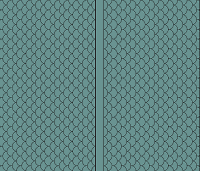
Roof graphic | |
Printing the Plans - If you have Adobe Acrobat Reader on your computer:
- Click here to open the pdf version of the first sheet. Select the print option, tell it to "auto rotate and center" or whatever else you need to make it go to Landscape mode. Don't select the "scale to page" or "shrink to fit" option. Print.
- Click here to open the pdf version of the second sheet. Print as you did the first sheet.
- Click here to open the pdf version of the third sheet. Print as you did the first sheet.
Note: If you are going to produce this building in 0 Scale or S Scale, use these plans as guidelines for how the building goes together, but take your dimensions for the building walls and ends from the graphic (less 2x the width of the cardboard you are using).
Printing the Graphics - We've provided several versions to help you print the "lithograph" graphics at the size you need.
Each sheet should be printed on acid-free high-grade paper or card stock. Note: Consider printing this sheet in black and white first to double-check the size against your existing equipment.
- As Shown - For use with O-gauge tinplate trains (such as Marx tinplate and smaller O27 trains), download the following graphics:
- Slightly Larger - If you want a slightly larger building for use with O scale trains download the following graphics. (Note: You will need to adjust the measurements on the building plans to match these graphics, minus 2x the width of the cardboard you are using. )
- Slightly Smaller - If you want a slightly smaller building for use with S scale trains or Christmas villages, download the following graphics:
(Note: You will need to adjust the measurements on the building plans to match these graphics, minus 2x the width of the cardboard you are using. )
Note about Other Sizes: If you want an HO building, try downloading the O scale graphics, then printing at 50%. If you need the lithographed-style graphics for large scales, contact Paul.
Also, if you don't have Adobe Acrobat Reader on your computer or for some reason that doesn't work, contact
Paul and ask him for help - that's his department. :-)
A note about Copyright - However you use these plans and graphics for your personal use, please keep in mind that the lithograph graphic is copyright 2009 by Paul Race and is not to be copied, re-used, republished, or repurposed without prior permission and appropriate credit. Commercial use without prior permission is illegal and expressly forbidden.
Big Indoor Trains(tm) is a participant in the Amazon Services LLC Associates Program, an affiliate advertising program designed to provide a means for sites to earn advertising fees by advertising and linking to amazon.com. Paul likes making resources like this available to hobbyists, but they are expensive and time-consuming to produce and publish, and it's frustrating to see other folks profiteering off his hard work. In other words, if you like having this kind of resource available and you'd like to see more, please respect the creator's rights. 
Building the Building Walls
I cut out the backing pieces for the side and end walls before I mounted the graphics to them. Note that you should adjust the lateral measurements of the backing pieces so that they are slightly less than the size of the lithograph sheet. (If a backing piece is a tiny bit narrower than it should be, you can nip an extra bit off of the lithograph sheet to make it fit, and camouflage the cut with a fine-tip marker. If a backing piece is a tiny bit wider than it should be, it's pretty hard to stretch the graphic paper to cover it.)
 I scored the folds and glued the walls together in a rectangle. Then I folded and glued the "roof tabs" as shown in the photo to the right. I scored the folds and glued the walls together in a rectangle. Then I folded and glued the "roof tabs" as shown in the photo to the right.
Building the Roof
After you have the basic frame assembled, try the roof pattern to make certain you are satisfied with the amount of overhang, etc. it provides.
A photo that shows the "trial" roof set on the building is a few inches down on this page.
Building the Base
 The base is a rectangular "box" built up from corrugated cardboard. The foundation will be covered once the building is fastened together, so it may be a single piece of thick corrogated cardboard or a piece of foam core board (shown). The base is a rectangular "box" built up from corrugated cardboard. The foundation will be covered once the building is fastened together, so it may be a single piece of thick corrogated cardboard or a piece of foam core board (shown).
- Make the base from three or four layers of corrugated cardboard glued together in a sandwich.
- Wrap and glue a strip of cereal-box cardboard all around it to camouflage the rough edges of the corrugated cardboard.
- When the base is built, cover it with white bond paper just like you would wrap a gift, except that all surfaces of the paper cover must be glued down to the box. A glue stick works great for this.
Note: For more information about building bases for vintage-style cardboard houses, please see our Glitterhouse Bases article.
 After you have built the base, cut the foundation piece out and set it loosely on the base. Position your building over it (as shown at right) to make certain it is a secure, but not overly tight fit. This photo also shows a "trial roof" set on the structure. After you have built the base, cut the foundation piece out and set it loosely on the base. Position your building over it (as shown at right) to make certain it is a secure, but not overly tight fit. This photo also shows a "trial roof" set on the structure.
Painting the Base
Once you're certain of the fit, prime the base and paint it with several coats of glossy paint in the color of your choice. Industrial gray was the color most often chosen for this kind of structure in the tinplate days. Dark green is also a candidate.
 Apply the Graphics Apply the Graphics
- Apply the printed graphics. Only do a section at a time. I like to start with the ends, as you can see in the photo to the right. Measure carefully, make crisp folds, apply glue and press in place.
- Trim the edges of the graphic paper, if necessary. The easy part of building this structure is that you don't have to do anything with the window and door frames.
 The hard part is getting the corners to line up exactly. The hard part is getting the corners to line up exactly.
- After the graphic sheets have dried in place, you will see white edges at the corner. With a black felt-tip pen, marker, or acrylic paint and a very tiny brush, carefully coat just the edge of the paper or card stock, trying not to make the printed lines any wider than they already are.
- Make
 certain that the roof is already creased and will bend to the angle you need before you apply the graphic. You may want to brace the roof somehow to keep it bent at the correct angle while the glue is drying. certain that the roof is already creased and will bend to the angle you need before you apply the graphic. You may want to brace the roof somehow to keep it bent at the correct angle while the glue is drying.
Final Assembly
Once the glue is dry on all of the graphics, it is relatively simple to glue the structure solidly together.  That said, you may want to check on it every so often to make certain the roof doesn't curl up or something doesn't shift out of place while it is drying. That said, you may want to check on it every so often to make certain the roof doesn't curl up or something doesn't shift out of place while it is drying.
Finish
Wait until all of the glue is thoroughly dry (usually at least overnight), then spray the building body with several light coats of a clear glossy indoor/outdoor acrylic finish. This protects it somewhat from moisture and dust. It also helps reduce fading and makes the lithography pattern "pop." Do not such a heavy coat in one pass that you cause any streaks, runs, or drips, though, or you'll have to start over.
If you have any turnouts (switches) on your railroad, try to set this structure nearby. If you don't, try to set it near your railroad water tower or other maintenance structures.
Conclusion
If you like this project, stay in touch - more are on the way. In the meantime, you might like to take a look at the following projects.
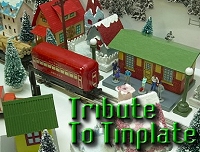 More "Tribute to Tinplate" Articles
Here's a series of projects that pay "Tribute to Tinplate," based on the tinplated-steel trains and towns of a century ago. Free downloadable commercial-grade graphics and instructions will help you inexpensively add an authentic vintage look to any indoor railroad. Most projects have multiple pre-scaled plans and graphics, plus scalable graphics for the smaller scales, so you can easily add a vintage look to ANY railroad or holiday village, no matter what size your trains and towns are. We have more on the drawing board, so be sure and check back. More "Tribute to Tinplate" Articles
Here's a series of projects that pay "Tribute to Tinplate," based on the tinplated-steel trains and towns of a century ago. Free downloadable commercial-grade graphics and instructions will help you inexpensively add an authentic vintage look to any indoor railroad. Most projects have multiple pre-scaled plans and graphics, plus scalable graphics for the smaller scales, so you can easily add a vintage look to ANY railroad or holiday village, no matter what size your trains and towns are. We have more on the drawing board, so be sure and check back.
- Building a Vintage Tin-Style Cottage
 This project is inspired by a popular pre-war tinplate house that was made to go with standard gauge trains, like the early 1900s-era Ives and Lionel. Our own commercial-quality graphics and instructions, as well as Howard Lamey's plans and assembly details are all free, to give your railroad a vintage tinplate look with a few cents' worth of materials. Many options are available, and most graphics and plans can be downloaded directly from the article. New, July, 2009! This project is inspired by a popular pre-war tinplate house that was made to go with standard gauge trains, like the early 1900s-era Ives and Lionel. Our own commercial-quality graphics and instructions, as well as Howard Lamey's plans and assembly details are all free, to give your railroad a vintage tinplate look with a few cents' worth of materials. Many options are available, and most graphics and plans can be downloaded directly from the article. New, July, 2009!
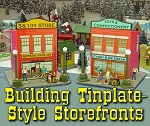 Building TinPlate-Syle Store Fronts -
Not one, but three buildings! The West Brothers tinpated candy boxes saved money by using one plan with multiple sets of graphics to get maximum use out of their pattern expense. We've followed their example with projects inspired by three of their most popular buildings. Use our free downloadable patterns and plans to add a vintage-style business district on your railroad or display village. Building TinPlate-Syle Store Fronts -
Not one, but three buildings! The West Brothers tinpated candy boxes saved money by using one plan with multiple sets of graphics to get maximum use out of their pattern expense. We've followed their example with projects inspired by three of their most popular buildings. Use our free downloadable patterns and plans to add a vintage-style business district on your railroad or display village.
 New
Feature - Building a Tinplate-Inspired Lamp Post The ideal accessory for the Lewis Park Station, or any station or city hall on your railroad or holiday village. No, they don't actually light, but they are cheap and easy to build and add a great deal of vintage interest to any setting. Free downloadable plans are available in several scales. New
Feature - Building a Tinplate-Inspired Lamp Post The ideal accessory for the Lewis Park Station, or any station or city hall on your railroad or holiday village. No, they don't actually light, but they are cheap and easy to build and add a great deal of vintage interest to any setting. Free downloadable plans are available in several scales.
 New
Feature - Building a Tinplate-Inspired Watchman's Shanty Back in the day before automated crossings, these were common sites alongside busy rail crossings. Howard's exclusive design pays tribute to a series of tinplate structures that go back a hundred years and include three different scales. His free plans and instructions will help you dress up any indoor railroad or holiday village. New
Feature - Building a Tinplate-Inspired Watchman's Shanty Back in the day before automated crossings, these were common sites alongside busy rail crossings. Howard's exclusive design pays tribute to a series of tinplate structures that go back a hundred years and include three different scales. His free plans and instructions will help you dress up any indoor railroad or holiday village.
 New
Feature - Building a Tinplate-Inspired Railroad Crossing Sign This is the ideal accessory for the Watchman's Shanty project. Based on a series of products that are now available only as expensive collector's items, this easy and almost-free project will add texture, interest, and period to any model railroad or holiday village. New
Feature - Building a Tinplate-Inspired Railroad Crossing Sign This is the ideal accessory for the Watchman's Shanty project. Based on a series of products that are now available only as expensive collector's items, this easy and almost-free project will add texture, interest, and period to any model railroad or holiday village.
- Easy Street Scene - This new
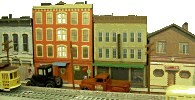 building project uses downloadable building graphics and a little cardboard or foam board to build up a convincing downtown scene that is only a few inches deep - perfect for shelf layouts, tight spots, and dioramas. We also provide links to high-resolution graphics that will work for any scale. building project uses downloadable building graphics and a little cardboard or foam board to build up a convincing downtown scene that is only a few inches deep - perfect for shelf layouts, tight spots, and dioramas. We also provide links to high-resolution graphics that will work for any scale.

 Build a Vintage-Style Cardboard Stone Cottage - This building project is made like the vintage cardboard houses folks used to set around their Christmas tree in the early 1900s (before glitterhouses became common), but its design was inspired by a building that shows up on the "Isle of Sodor." The building uses free downloadable graphic paper to put a realistic stone veneer on an old-world cottage and fence. It works with Christmas villages, or with a little customization, would dress up any indoor railroad. A "brick cottage" option is also shown.
Build a Vintage-Style Cardboard Stone Cottage - This building project is made like the vintage cardboard houses folks used to set around their Christmas tree in the early 1900s (before glitterhouses became common), but its design was inspired by a building that shows up on the "Isle of Sodor." The building uses free downloadable graphic paper to put a realistic stone veneer on an old-world cottage and fence. It works with Christmas villages, or with a little customization, would dress up any indoor railroad. A "brick cottage" option is also shown.
 Log Cabin Building Flat - This "building flat" uses downloadable graphics and foam board or cardboard to dress up a narrow corner of your railroad or village. The techniques in this project can be used for almost any kind of building you want to represent in a tiny space. December, 2007 Log Cabin Building Flat - This "building flat" uses downloadable graphics and foam board or cardboard to dress up a narrow corner of your railroad or village. The techniques in this project can be used for almost any kind of building you want to represent in a tiny space. December, 2007
- Build a Vintage-Style Barn and Silo - This
 building project uses downloadable graphics to put realistic shingles and siding on an old barn and silo. Like the stone cottage above, it works with Christmas villages, or with a few changes, it would dress up an indoor railroad. building project uses downloadable graphics to put realistic shingles and siding on an old barn and silo. Like the stone cottage above, it works with Christmas villages, or with a few changes, it would dress up an indoor railroad.
 Building the Union Station - This original project by designer Howard Lamey is inspired by two traditions - the cardboard Christmas houses that were popular in US homes between 1928 and 1965 and the Lionel station that was popular for most of the 20th century. Building the Union Station - This original project by designer Howard Lamey is inspired by two traditions - the cardboard Christmas houses that were popular in US homes between 1928 and 1965 and the Lionel station that was popular for most of the 20th century.
Other Articles about cardboard houses include:
To Return to the BIG Indoor Trains(tm) Primer Page, click here.
|




|












 The base is a rectangular "box" built up from corrugated cardboard. The foundation will be covered once the building is fastened together, so it may be a single piece of thick corrogated cardboard or a piece of foam core board (shown).
The base is a rectangular "box" built up from corrugated cardboard. The foundation will be covered once the building is fastened together, so it may be a single piece of thick corrogated cardboard or a piece of foam core board (shown).
















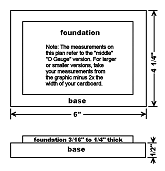










 More "Tribute to Tinplate" Articles
More "Tribute to Tinplate" Articles
 Building TinPlate-Syle Store Fronts
Building TinPlate-Syle Store Fronts New
Feature - Building a Tinplate-Inspired Lamp Post
New
Feature - Building a Tinplate-Inspired Lamp Post New
Feature - Building a Tinplate-Inspired Watchman's Shanty
New
Feature - Building a Tinplate-Inspired Watchman's Shanty New
Feature - Building a Tinplate-Inspired Railroad Crossing Sign
New
Feature - Building a Tinplate-Inspired Railroad Crossing Sign




 Building the Union Station
Building the Union Station